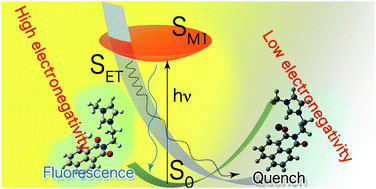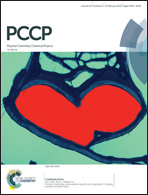Theoretical study on photo-induced processes of 1-methyl-3-(N-(1,8-naphthalimidyl)ethyl)imidazolium halide species: an application of constrained density functional theory†
Abstract
1-Methyl-3-(N-(1,8-naphthalimidyl)ethyl)imidazolium (MNEI) has potential as a versatile sensor that can measure the electronegativity of anions based on the fluorescence intensity upon irradiation. To clarify the factors that determine the fluorescence intensity, constrained density functional theory (CDFT) was applied to explore the electron transfer (ET) states of MNEI halide species (MNEI–X; X = F, Cl, Br, I). According to the CDFT potential energy surface, intra-molecular ET (SM1) states on MNEI are responsible for the intensity of absorption and fluorescence spectra. However, inter-molecular ET (SET) states between MNEI and X are certainly responsible for fluorescence quenching. Hence, the energetic difference between the SM1 state and the SET state (ΔEM1_ET) is a crucial factor that determines the fluorescence intensity in the spectra of MNEI–X complexes. ΔEM1_ET decreases as the electronegativity of X decreases (i.e., F > Cl > Br > I). This explains the fluorescence intensity of MNEI–X.



 Please wait while we load your content...
Please wait while we load your content...